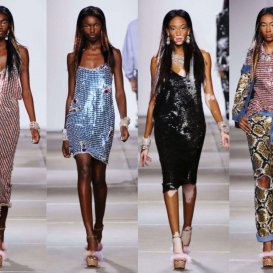BLACK IS the universal colour choice of fashion, but not of the people who run it.
The fashion industry influences people all over the world. It’s an exemplar. High streets try to mimic the latest trends and people of all backgrounds aspire to be a part of the billion pound production. Yet in all its prestige, it fails to have an honest message of diversity and nosedives at the chance to be the trend setter of equality.
For something as subjective as beauty, there has been little progress since the first black model Donyale Luna, graced the front cover of Vogue in 1966. A ritual that seems to be the epitome of what makes you a supermodel. Yet, there hasn’t been a black model on the front of British Vogue since Naomi Campbell in 2002. In 2011, the French version placed their first ever East Asian model Du Juan on their front cover, with Italy following in 2013 with Chinese model Fei Fei Sun. Horrendously, the UK and USA have yet to do so. There is an unnerving sense that you can count these models on one hand.
We live in a multicultural society yet there seems to be little fight from the rest of the fashion industry to challenge beauty standards, with only a small number of non-white models rising to fame and becoming tokenised trophies. At New York Fashion Week 2013, the magazine Jezebel monitored the racial diversity with disappointing results. Out of 4479 outfits that were modelled, 3706 (82.7 per cent) were done so by white people, leaving 773 outfits for everyone else. Calvin Klein was a part of the 9 per cent of designers that had no people of colour at all. This year we saw a slight improvement as the figures dropped to 78.69 per cent, but in reality this illustrates a pathetic effort. Ideally, western countries should be a reflection of the variety of people that inhabit them.
There seems to be conflict whenever designers choose ethnic models. If there is one black model out of ten white models, it seems as though it is a poor attempt to tick the diversity box. Indian-born, London-based fashion designer Ashish was put under question for his all-black casting of models in his Spring/Summer 2015 show. He rightly replied, “It struck me that if I’d used all white models, no one would have questioned it.” But does this just work when non-white designers do it? Rick Owens, who normally predominately uses a white cast, caused controversy at his show in Paris as he replaced models with majority black women Step groups, a dance that has links to South African gumboot dances that were performed to entertain coal miners, but also became a dance of protest during apartheid. On the surface it is refreshing and original to see generally plus sized, strong women doing a culturally deep rooted routine opposed to the expected catwalk with stereotypical models. But, there is something gimmicky about his decision as he declared his choice of models as anti-beauty and directing the women to use angry faces it shows his misunderstanding of the emotion behind the performance.
Occasionally, designers use their collections as a voice for campaigning, but from such a privileged assembly of people it often becomes like a beauty pageant speech. A way to sell yourself as conscious and radical by manipulating a cause for that one hour in the spotlight. Belgian designer Walter Van Beirendonck used his catwalk as an opportunity to literally spell out “Stop Racism” on large feathered headdresses. This is a dig at people disrespectfully imitating Native American culture, including the likes of Chanel’s Karl Lagerfeld as he took his turn in exploiting their culture. However Beirendonck undermined his actions by only hiring four people of colour for his show.
In response to the underrepresentation of people of the population, last year Naomi Campbell along with agent Bethany Hardison and model Iman launched Diversity Coalition, a campaign that names and shames designers who fell in to the category of unrepresentative models. It is this calling out and sharing of evidence which will hopefully force the designers to be more conscious of their output to the world.
It is true the fashion industry does not inhabit a different world separate to the divided one that surrounds us. Racism is alive as ever. The recent verdict that police officer Darren Brown was not going to be charged for the murder of teenager Michael Brown is one example of this. The fact we still have many far right parties whose main political agenda focuses on “immigration” is another. It isn’t the fault of beautiful outfits or of the creative individuals who design them. However, with such an influence on aesthetics and acceptance, as an industry there needs to be a change of attitude, as some designers are still requesting “no ethnics”. Having an all-white cast sends an atrocious message. In simple words it says white is better.









